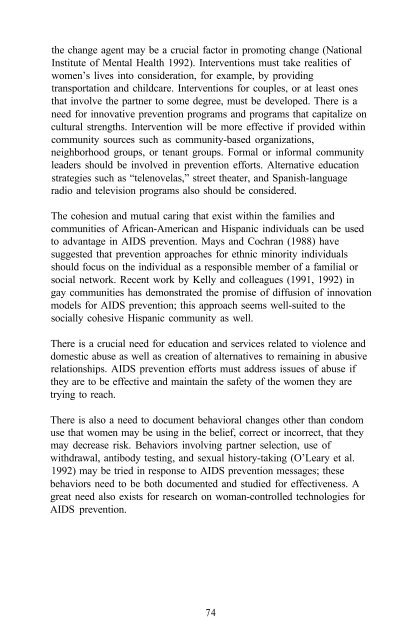The Context of HIV Risk Among Drug Users and Their Sexual Partners
The Context of HIV Risk Among Drug Users and Their Sexual Partners
The Context of HIV Risk Among Drug Users and Their Sexual Partners
You also want an ePaper? Increase the reach of your titles
YUMPU automatically turns print PDFs into web optimized ePapers that Google loves.
the change agent may be a crucial factor in promoting change (National<br />
Institute <strong>of</strong> Mental Health 1992). Interventions must take realities <strong>of</strong><br />
women’s lives into consideration, for example, by providing<br />
transportation <strong>and</strong> childcare. Interventions for couples, or at least ones<br />
that involve the partner to some degree, must be developed. <strong>The</strong>re is a<br />
need for innovative prevention programs <strong>and</strong> programs that capitalize on<br />
cultural strengths. Intervention will be more effective if provided within<br />
community sources such as community-based organizations,<br />
neighborhood groups, or tenant groups. Formal or informal community<br />
leaders should be involved in prevention efforts. Alternative education<br />
strategies such as “telenovelas,” street theater, <strong>and</strong> Spanish-language<br />
radio <strong>and</strong> television programs also should be considered.<br />
<strong>The</strong> cohesion <strong>and</strong> mutual caring that exist within the families <strong>and</strong><br />
communities <strong>of</strong> African-American <strong>and</strong> Hispanic individuals can be used<br />
to advantage in AIDS prevention. Mays <strong>and</strong> Cochran (1988) have<br />
suggested that prevention approaches for ethnic minority individuals<br />
should focus on the individual as a responsible member <strong>of</strong> a familial or<br />
social network. Recent work by Kelly <strong>and</strong> colleagues (1991, 1992) in<br />
gay communities has demonstrated the promise <strong>of</strong> diffusion <strong>of</strong> innovation<br />
models for AIDS prevention; this approach seems well-suited to the<br />
socially cohesive Hispanic community as well.<br />
<strong>The</strong>re is a crucial need for education <strong>and</strong> services related to violence <strong>and</strong><br />
domestic abuse as well as creation <strong>of</strong> alternatives to remaining in abusive<br />
relationships. AIDS prevention efforts must address issues <strong>of</strong> abuse if<br />
they are to be effective <strong>and</strong> maintain the safety <strong>of</strong> the women they are<br />
trying to reach.<br />
<strong>The</strong>re is also a need to document behavioral changes other than condom<br />
use that women may be using in the belief, correct or incorrect, that they<br />
may decrease risk. Behaviors involving partner selection, use <strong>of</strong><br />
withdrawal, antibody testing, <strong>and</strong> sexual history-taking (O’Leary et al.<br />
1992) may be tried in response to AIDS prevention messages; these<br />
behaviors need to be both documented <strong>and</strong> studied for effectiveness. A<br />
great need also exists for research on woman-controlled technologies for<br />
AIDS prevention.<br />
74
















